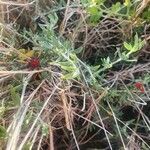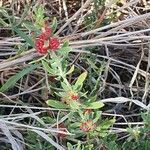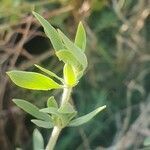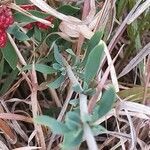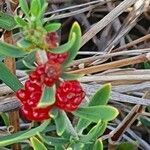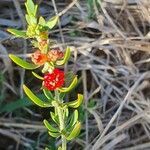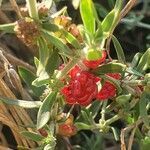Perennial herb, 0.08-1.50 m high; branches terete, white-woolly. Leaves opposite, verticillate, stipulate, grey-green, hairy with white crinkled hairs, glabrescent later, narrowly oblanceolate, linear-oblanceolate or very narrowly elliptic. Inflorescence a cyme, 5-many-flowered. Sepals lanceolate-oblong, apex subobtuse, pubescent or glabrous. Petals white, deltoid. Stamens 1 or 2. Ovary ellipsoid. Flowering time Aug.-Apr. Fruit a capsule, ellipsoid, surrounded by persistent, fleshy, waxy, white bracts. Seeds ellipsoid.
A herb or small shrub. It has many branches. It grows 60 cm tall. The young branches have a white woolly covering. The leaves are grey-green. They are 1-3 cm long by 0.5 cm wide. They are narrowly sword shaped. The flowers are in groups of 5. The petals are white. The fruit is a capsule 1.3 mm long by 0.7 mm wide. There is usually one seed 0.8 mm long by 0.5 mm wide. The fruit are edible.
Leaves grey-green, 0·5–3·2 × 0·5–0·9 cm., narrowly oblanceolate, linear-oblanceolate or very narrowly elliptic, apex acute, apiculate, narrowed to a subsessile base, hairy with white crinkled hairs or glabrescent later; stipules white, 2–4 mm. long, scarious, lanceolate-acuminate, entire or toothed, pubescent or glabrescent.
Dwarf shrub, up to 0.6 m high; much branched. Leaves opposite, often arranged in false whorls. Flowers: in dense, axillary clusters; infructescence succulent, berry-like, translucent, swollen fleshy bracts waxy white or dull orange; perianth white; Nov.-May. Fruit a nut.
Silky hairy shrublet, up to 600 mm tall. Leaves opposite or apparently verticillate, oblanceolate, apiculate, greyish green. Flowers in axillary clusters, greenish yellow, enclosed by fleshy, waxy, white bracts in fruit, edible. Flowering throughout the year.
Silky hairy shrublet to 60 cm. Leaves opposite or apparently verticillate, oblanceolate, apiculate. Flowers in axillary clusters, greenish, enclosed by fleshy, waxy white bracts in fruit.
Receptacle c. 1 mm. long, cupuliform but usually somewhat constricted at the insertion of the sepals, pubescent or glabrescent outside, minutely glandular-papillose.
Petals inserted at the mouth of the receptacle, white, c. 0·12 mm. long, deltoid, with a rounded scale (? disk-lobe) of the same height in front of each petal.
Seeds 1 (2), 0·8 × 0·5 mm., ellipsoid, the curved embryo showing clearly through the transparent testa and endosperm (at least when wet).
Small shrublet, often much branched, up to c. 60 cm. tall; branches terete with a white woolly indumentum at least when young.
Cymes 5-?-flowered; bracts c. 1·5 mm. long, similar to the stipules when young but acute rather than acuminate.
Swollen fleshy bracts waxy-white or rarely dull orange (north of our area they are often recorded as scarlet).
Ovary ellipsoid; style c. 0·6 mm. long, filiform, often twisted and curled, very shortly bifid at the apex.
Sepals 0·5 mm. long, rather thick, lanceolate-oblong, apex subobtuse, pubescent or more usually glabrous.
Capsule c. 1·25 × 0·7 mm., ellipsoid, surrounded by the persistent receptacle and calyx.
Stamens 1–2, ± equalling the sepals.
